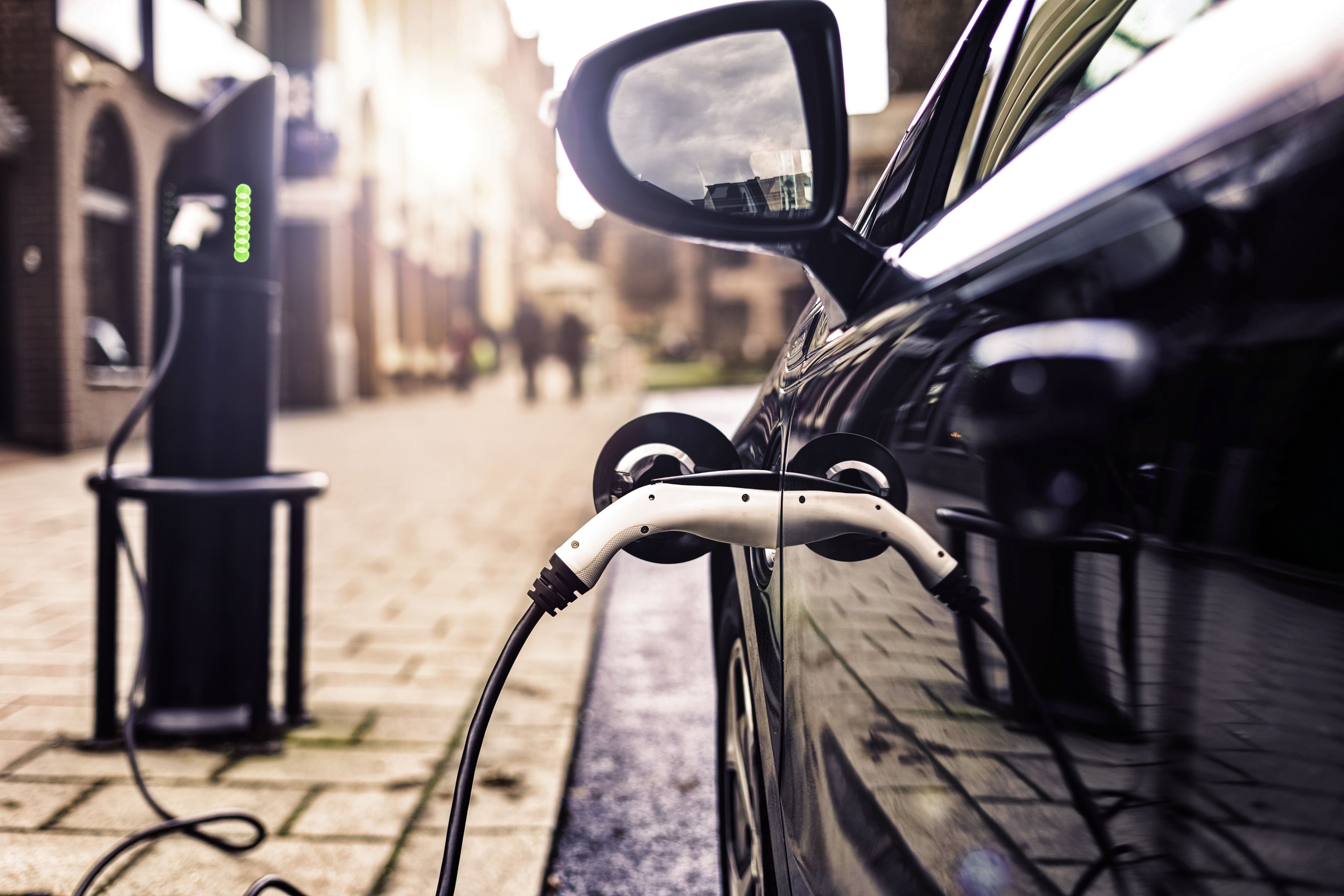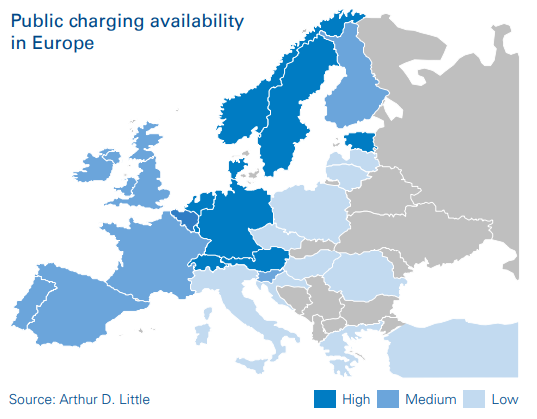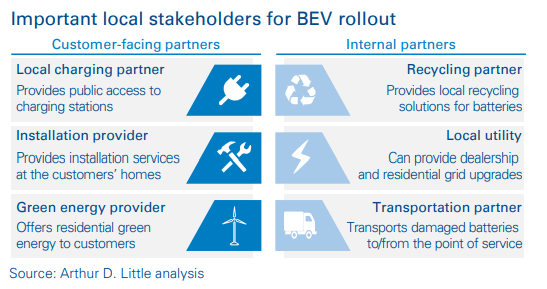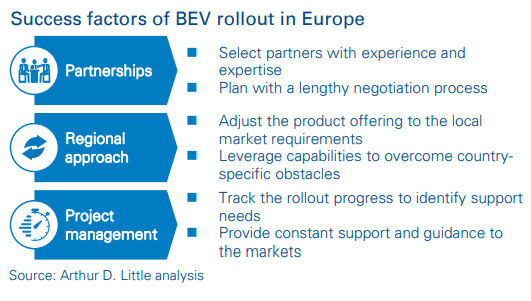
From 2017 to 2018, electric vehicle sales in EU/EFTA countries grew significantly, by almost 40 percent (Battery Electric Vehicle (BEVs) at almost 50 percent). The EV share of sales was, however, only at 2.3 percent – more than half of which were BEVs. Markets in the region developed very differently, with approximately 25 percent of all BEV sales driven by Norway. Nonetheless, to meet ambitious emission reduction targets and emerging customer demand, and to benefit from growing government support, car manufacturers are starting to launch EVs in smaller European markets as well. Arthur D. Little’s experience shows how to successfully roll out and launch BEVs in these yet-immature EV market environments, where importers and dealer networks often face limited customer potential, with few resources.
BEV rollout is a major challenge to importers and NSCs with limited human and financial resources
When thinking about the European automotive market, we tend to focus on Germany, the UK or France. However, smaller markets such as Finland and Portugal remain relevant for OEMs in terms of sales volumes. More importantly, the examples of Europe’s big EV markets in terms of sales volume and relative market share – Norway, the Netherlands, and Sweden – show that market-specific conditions can easily make the typically “small” markets “big” for BEVs. However, due to relatively small sales volumes of conventional cars and limited numbers of dealerships, smaller markets often appear to be short-staffed. Not only do many markets lack sufficient on-site capacity to promptly perform the necessary rollout activities for BEVs, but oftentimes, they also lack sufficient financial resources to cope with the necessary upfront infrastructure investments. Responsibilities for importer levels for dedicated sales, marketing or after-sales activities dedicated to BEVs in those markets are typically assigned to very small teams – or even to single employees, who face significant numbers of questions and challenges. The introduction of the first BEV raises questions that are often complex, cross-functional and mostly new to “petrol-heads”. Small importer organizations therefore quickly find themselves in strained situations during the BEV market implementation.
ADL’s experience from electric vehicle rollouts in Europe can be summarized in 10 key learnings:
- Full-time personnel with clear responsibilities for BEV rollout are required at all levels of importers and national sales companies.
- Leveraging PHEV infrastructure and experience in markets is crucial.
- Small dealer networks reduce rollout complexity.
- Dealer set-up is critical and time-consuming.
- Electric grid performance in European homes is sufficient to charge BEVs overnight, but special charging equipment may be required.
- Public charging availability is still critical in many smaller markets – the focus is on home charging.
- New after-sales processes for BEVs ensure sufficient time for adjustments in rollout.
- BEV ecosystems are set up in all European markets – companies must ensure sufficient time for partnering.
- Tailor rollout to markets, or at least market clusters.
- Constantly track and support smaller markets.
Full-time personnel with clear responsibilities for BEV rollout are required at importer and NSC level
Requirements during the rollout of battery electric vehicles differ from the launch of any conventional new vehicle or model line.The set-up and rollout of value-adding technology and solutions, e.g., for charging, requires additional management capacity early in the process. Additional investments in resources pay off when the rollout timelines are stuck to and BEVs are launched successfully, with high customer acceptance.
Prior to the rollout, it is crucial to dedicate people with clear mandates, in order to avoid delayed market launches or overburdened teams in later phases. This is key in both OEM headquarters and in importer market organizations. Examples of successful OEMs show that only a fully dedicated rollout team with clear responsibilities and tasks can manage the complex challenges – as opposed to an ordinary project set-up that only involves adding tasks to the project staff’s daily job routine.
Leveraging PHEV infrastructure and experience in markets is crucial
As many car manufacturers have previously introduced plug-in hybrid electric vehicles (PHEVs), importers can build upon the knowledge and experience from past rollouts. Often, basic electric vehicle infrastructure, knowledge of legal requirements, and first EV-related after-sales processes are already in place. This facilitates the rollout process and leads to smoother implementation, if used in a smart way. OEMs and importers should, for example, build on their agreements with installation partners for wall boxes at customers’ homes, with utilities for green energy contracts, as well as high-voltage battery service and recycling partners. However, regardless of whether PHEVs exist in the market, most importers and retailers will require guidance and support from OEMs to gain clear understanding of the key issues linked to the rollout of pure BEVs.
Small dealer networks reduce rollout complexity
Smaller automotive markets in Europe often have a striking advantage: rollouts are substantially less complex than in larger markets due to the comparatively small number of dealerships and service locations. Instead of preparing, training, equipping and supplying hundreds of business partners or outlets, importers can focus on BEV sales networks that are limited to a dozen or less locations, e.g., in the capital and primary cities of the country. As a result, implementation activities and dependencies on capacity bottlenecks in the central organization are reduced. The rollout process becomes more manageable and less stressful for all involved parties. On the flip side, less routines and large-scale processes are set up and applied. Rollout at a handful of dealers will most likely follow a tailored approach and heavily rely on personal alignments. If this fact is considered and reflected in processes and the rollout timeline, e.g., by focusing resources and leveraging good personal relationships between importer and dealers, small dealer networks can facilitate the vehicle rollout.
Dealer set-up is critical and time-consuming
Nevertheless, the dealer set-up remains a critical and timeconsuming part of the rollout. Particularly time-consuming activities include:
- Preliminary grid connection checks with external partners
- Amendments or changes to dealer contracts
- Installation of required hardware at dealer locations
- Training of sales and after-sales personnel
In terms of electrical grid capacity, one should look ahead at larger BEV volumes in the future. With multiple vehicles charging at the same time, grid-capacity limits can be quickly reached. In many markets, external partners need to perform grid checks. It turns out that in most of Europe’s smaller markets, the average available buffer for dealerships is somewhere between 40 and 80 kW. In case of insufficient power supply, the dealer should evaluate the feasibility of a power upgrade with its utility provider, or investment in an often even more expensive battery buffer solution.
Electric grid performance in European homes is sufficient to charge BEVs overnight
Among current customers in European markets, residential home charging is the prevalent way to charge BEVs, given that the vehicle is typically parked at home for the longest portion of the day. In Europe, home charging accounts for almost 80 percent of total charging. Since many European households are already equipped with three-phase electric-current connections, with 400 volts and 16 or 32 amps, the maximum-possible charging power typically ranges from 11 to 22 kW.
As a result, even vehicles with the largest-available batteries can be fully charged within six to eight hours. Since 80 percent of all private commutes are, on average, less than 60 km per day, an 11 kW connection easily covers most charging needs for daily driving distances. But OEMs need to consider that emphasizing home-charging solutions somewhat limits the group of potential customers to those who have access to dedicated parking lots with lockable and protected electricity supplies.
Public charging availability is still critical in many smaller markets – focus is on home charging
The possibility of charging vehicles at public locations greatly differs across European markets. Whereas countries such as Norway and the Netherlands have approximately 200 stations per 100,000 citizens and dense networks of available locations, EV drivers in countries such as Greece and Bulgaria have barely any public charging spots. In these markets, OEMs, importers and dealers especially need to work on public charging opportunities in order to reduce range anxiety and skepticism among customers regarding the usability of EVs. In most European countries, public charging networks require customers to register for authorization and payment. OEMs and importers can enter agreements with external charging partners to increase user convenience. Official partnering with existing charging networks usually improves the way customers perceive the vehicle charging ecosystem – as examples such as ChargeNow and the upcoming Ionity network show.

In some markets, rollout planning is rendered even more complicated as different types of charging plugs are in use. However, after initial disagreement over the optimal plug for electric vehicles in Europe, the CCS is becoming the dominant DC charging standard in Europe.
Our analysis has shown that more and more local and national utilities, tech start-ups and petrol suppliers are establishing themselves in the fast-growing business of public EV charging stations. This represents an opportunity for OEMs in smaller markets to form partnerships and develop white-label charging solutions
A number of car manufacturers, including BMW, Daimler, Volkswagen, Audi, Porsche and Ford, have teamed up in the Ionity joint venture to deploy an 800 V/350 kW charging network across the continent by 2020. These high-performance charging stations are bringing an interoperable charging infrastructure to European motorways, allowing BEVs to recharge for hundreds of kilometers in less than half an hour.
New aftersales processes are required for BEVs – as well as sufficient time for adjustments in rollout
Electric mobility will decisively change the after-sales business for OEMs, importers and dealers. Changes range from different workshop equipment requirements to employee qualification and workload. The important spare-parts business is also heavily affected. Preparing the after-sales has turned out to be the most time-consuming and complex part of rollout planning and preparation for many OEMs in smaller European markets. Many maintenance procedures and wear repairs related to the combustion engine will become obsolete, which will reduce revenue and profits for workshops, OEMs and parts suppliers. Even brake replacements are partially affected, since recuperation takes some load from conventional brake systems, which leads to longer replacement cycles.
The servicing of BEVs requires additional qualifications for workshop staff, such as high-voltage handling certificates and special safety trainings. In addition to qualifications for employees, service centers need to be equipped with BEVspecific tools, including lifting and transport equipment for highvoltage batteries and high-voltage battery workstations for repair or replacement of battery components. Given these specific aftersales needs, OEMs should plan for ample time to ensure compliance with regulatory requirements and successfully implement the processes. Rolling out after-sales capabilities across dealerships could follow a staged approach, with initialfocus dealerships taking the lead.
BEV ecosystems are set up in all European markets – companies must ensure time for partnering

Importers are increasingly entering into partnerships to facilitate sustainable energy concepts, innovative charging technologies and green business models. Interface design and joint projects between importers and external partners (e.g., utilities, installation, or battery recycling partners) are key success factors for marketing BEVs. Only with external partners can OEMs ensure a seamless and satisfying BEV customer journey.
Building new partnerships often proves to be time-consuming, as objectives, processes and responsibilities need to be defined, and the right partners for each market need to be identified and approached. With the introduction of PHEVs, many markets have already started to form cooperation agreements. In most cases, however, these agreements need to be adapted to the specific requirements of BEVs. Installation providers, for instance, need to consider additional charging equipment and higher charging loads. Similarly, recycling and transportation processes likely need to be adapted for BEV batteries. In these cases, it becomes crucial to provide required information early to importers and partners, so BEV-specific processes can be adjusted in time, together with installation providers or recycling and service partners.
Tailor rollout to clustered markets
The BEV product offering and market introduction approach should be adapted to the size and complexity of each market, in order to guarantee an efficient rollout. Even though Europe is quite homogeneous in terms of regulatory environment, a BEV rollout cannot use a “one size fits all” approach: country-specific characteristics such as political and infrastructural factors can jeopardize the success of the rollout. Government incentives and subsidies, for example, will have a significant impact on the number of expected sales and the required offering portfolio. Customer-specific requirements can vary according to driving and housing habits. Clustering markets according to EV-related market specifics therefore helps to generate synergies between markets and processes, and saves resources during the rollout.

Constantly track and support smaller markets
In the initial rollout phase and through internal workshops, it is important to get all stakeholders aligned by prioritizing and discussing rollout activities, tasks and dependencies in detail. All stakeholders must have been identified, and everyone needs clarity on the project’s objectives and outputs. Subsequently, regular progress tracking will be essential to identify local support needs early on. Ultimately, the level of support and guidance provided by the OEM will determine the effectiveness of the overall rollout.
Conclusion
Electric mobility will fundamentally change the automotive and car business in all European markets, not only in Germany, the UK and France. This change represents a major challenge along the entire value chain, not only for established automobile manufacturers, but also for the national sales companies and importers in individual markets.
Examples of electric vehicle shares in Norway and the Netherlands show that the market uptake of EVs can take place quickly, provided the right conditions are in place. Other European markets will likely follow in the near future, because in Europe in particular, stricter emission limits and the poor image of combustion engines are giving an additional boost to alternative, environmentally friendly powertrains.



